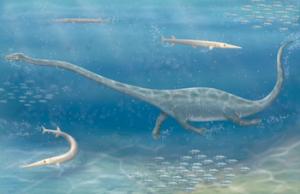A long-necked predator in the sea
Scientists have discovered a long-necked reptile, with fangs, that seems to hunt fish and squid in shallow waters that are present in the South China Sea more than 230 million years ago. The animal has a neck that is 1.7 meters long (twice the length of the body) and quite solid. This finding was published in Science magazine on September 24, 2004.

(Photo: sciencedaily)
This animal is fully described as a member of a reptile group called Protorosaurs, characterized by a long neck. Comparing this new species with the long-necked reptiles and the protorosaurs of Europe and the Middle East (Tanystropheus) has shown an insight into the methods of hunting as well as their evolution and diversity Triassic period.
Olivier Rieppel (Field Museum, Chicago) said that some authors have made judgments about the hunting methods of marine objects, but through this new species we may have to reconsider the How did Tanystropheus and other protorosaurs use ancient hunting.
Chun Li - from Chinese Academy of Sciences in Beijing - discovered the species and named Dinocephaloaurus orientalis, meaning 'lizard has a terrible head from the east', after examination broke the skull 23.5 cm (about 9 inches) in the autumn of 2002 in Guizhou province. This skull has 3 canines in the upper jaw with the length in the previous order: 1.5 cm, 2.8 cm and 2.3 cm.
Later that year, in this marine limestone area Li discovered a nearly intact skeleton of the first protorosaur in China. This skull is 15.5 cm long (about 6 inches)
Dinocephalosaurus has a rather short, large body and contains less bone than other protorosaurs, which have shown that the body structure is fully adapted to aquatic life. Chu Li claimed that Dinocephalosaurus laid eggs on land because of its strong body skeleton structure, easily moving on the ground.
To breathe, Dinocephalosaurus probably held its neck parallel to the water because the hydrostatic pressure of the surrounding water environment prevented the lungs from expanding as it moved its head vertically to get air.
Both Dinocephalosaurus and Tanystropheus have rib-like bones that stretch in the direction parallel to the neck, and limit the movement of the neck. The authors argue that Dinocephalosaurus' long neck can hunt in two ways:
It can attack prey surprisingly thanks to its very long neck and small head. The teeth and canines are arranged unlike other protorosaurs, so the animal can extend its jaws like a crocodile.
Co-author Michael LaBarbera from the University of Chicago, Illinois proposed the second method of hunting. With this method, when hunting the neck muscles Dinocephalosaurus shrinks, causing the neck to straighten very quickly, the neck veins spread out, to widen enough to swallow the prey under the pressure created by the head's movement. In this way they can perform attacks on relatively large prey in the country.
While it is difficult to add muscles to fossils when there is little or no evidence of muscle based on fossil studies. Rieppel said his ideas were based on the structure of the bones, the mechanical rules and the complexity of hunting in the water, a dense environment that could alert prey very soon before the object had can attack.
Authors :
Chun Li - Institute of Vertebrate Paleontology and Paleoanthropology, Chinese Academy of Sciences, Beijing.
Olivier Rieppel - The Field Museum in Chicago, Illinois;
Michael LaBarbera - University of Chicago in Chicago, Illinois.
- The falcon robs the young red-necked bird from the nest in the blink of an eye
- Discover long-necked dinosaurs in the ice continent
- Brazil discovered the world's oldest long-necked fossil dinosaurs
- The long-necked sea monster in the UK may be a new dinosaur
- Long-necked dinosaurs do not face the neck up high?
- Why are long-necked dinosaurs gigantic?
- Finding dinosaurs with super long necks
- Dinosaurs also migrate
- Discover the village with strange long-necked women
- The long-necked creature resembles the Loch Ness monster in Russia
- Finding dinosaurs like the Loch Ness monster
- New discovery: Giraffes belong to 4 different organisms
 Discovered an ancient centipede fossil 99 million years old
Discovered an ancient centipede fossil 99 million years old Discovered bat-like dinosaurs in China
Discovered bat-like dinosaurs in China Discovered a 200-year-old bronze cannon of the coast
Discovered a 200-year-old bronze cannon of the coast Discover 305 million-year-old spider fossils
Discover 305 million-year-old spider fossils Why can neck and shoulder massage be deadly?
Why can neck and shoulder massage be deadly?  The ancient female vampire's grave is still 'sealed'
The ancient female vampire's grave is still 'sealed'  The shocking part that upgrades the Jurassic 'snake head' into a monster
The shocking part that upgrades the Jurassic 'snake head' into a monster  A simple way to check your thyroid at home
A simple way to check your thyroid at home  Regardless of whether male or female, these two parts of the body are bigger and more life-threatening
Regardless of whether male or female, these two parts of the body are bigger and more life-threatening  Pain in the neck, shoulders, or neck is not caused by sitting in the wrong position!
Pain in the neck, shoulders, or neck is not caused by sitting in the wrong position! 